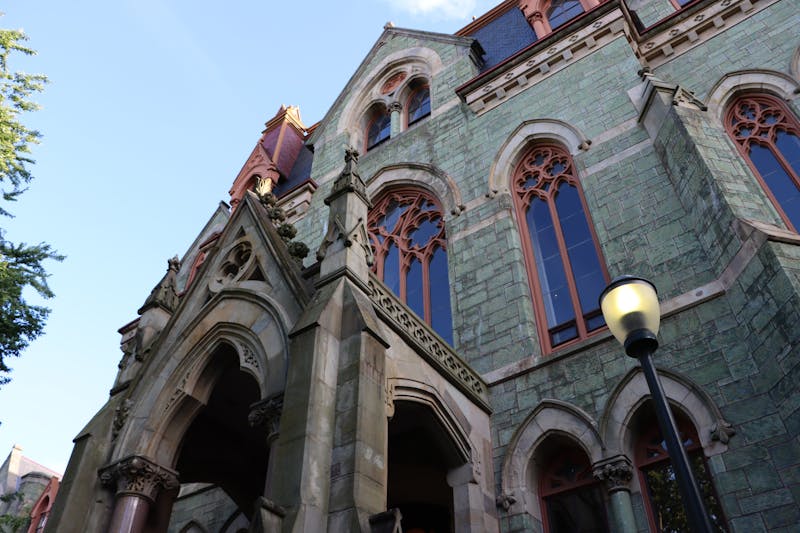It's been said that war is the only way to teach Americans geography. And maybe this time around, they'll learn even more -- after all, the U.S. is bombing the cradle of civilization.
Not everyone may realize that the core of what was once ancient Mesopotamia is now the modern-day state of Iraq.
"Iraq is a country with a long and very rich history," says Richard Zettler, professor of anthropology and associate curator at the University Museum of Archaeology and Anthropology.
And to a striking extent, the history of Iraq belongs to all of human civilization. It is the birthplace of writing, the site of Ur -- homeland of the biblical Abraham -- and home to great Islamic dynasties.
The list is endless, but the tangible remains are not. And with the second Gulf War now in full swing, while humanitarian concerns come first, archaeologists and art historians are also concerned for the safety of Iraq's historical monuments and sites -- the last remnants of the region's abundant, once flourishing ancient cultures.
•
The entire country of Iraq is an archaeological gold mine.
"There are just thousands of archaeological sites," Zettler says.
"There are a lot of answers there just sitting and waiting for someone to find," says Erika Tapp, a second-year art history graduate student.
"The thing about archaeology is that you can't recover it once it's gone," says Stephennie Mulder, also a second-year art history graduate student. "All of that depends on stratographic relationships that are completely destroyed."
Mulder is referring to the importance of context in an archaeological find. The location of an object relative to others often provides archaeologists with important clues.
For instance, ruin mounds -- rife with historical significance -- are subject to use by the military since they are often the only high ground available.
Zettler, however, is relatively optimistic given the situation.
"Even if you were to hit one of these ruin mounds with a bomb -- yeah, you'll put a crater in it," he says. "But these are big sites, so I think... short of a nuclear explosion, the amount of damage would be relatively minimal."
Conflict, however, is not the only cause of damage to archaeological sites.
"Farmers in this area use the soil from archaeological sites as fertilizer for their fields," Zettler says. "The simple fact is that the archaeological sites are being destroyed by all kinds of human activities all the time."
•
Archaeological sites are one thing. Standing monuments are quite another.
"These monuments have lasted all this time because of their special nature -- they were wonders of the world when they were built," says Renata Holod, art history professor and curator at the University Museum.
The huge vaulted arch of Ctesiphon is all that remains standing of the famed Sassanian Palace -- yet, it too remains in grave danger after suffering cracks during the first Gulf War.
Another site of particular interest is the great palace city of Samarra, 21 kilometers outside of Baghdad. All that remains is the so-called "minaret of Samarra."
"These are feats of engineering construction imagination," Holod says. "It would be tragic if they were destroyed."
•
Monuments are not only important as historical records. They also play a significant role in cultural identity.
"To come in contact with things that you know have been touched and used and seen by people that are otherwise completely foreign to you, it's really incredibly powerful," says College junior Meredith Gamer, who has just finished researching iconoclasm.
"Monuments play a key role in rebuilding people's identity after a conflict is over, and that's really the main reason why they're important to preserve," Mulder says.
The loss of a site is especially poignant to some when it has religious significance.
Take Karbalah and Najaf, two cities southwest of Baghdad, which are two of the holiest sites in the world for Shiite Muslims.
•
But the gravest problems may be yet to come.
In the aftermath of the first Gulf War, Iraq's thousands of archaeological sites and prestigious museums were ransacked and looted.
Some of the stolen items can be found today on eBay. Others found their way onto the black market.
"The Iraqi museum holds at least half, if not more, than that of everything that's been excavated in Iraq since Iraq was founded," Zettler says. "If the artifacts and the field records are lost, then everything is gone."
Often desperate for sources of income during the tough times of economic sanction, Iraqis loot sites and museums in order to feed their families.
Still, cultural organizations have issued various petitions and continue to make valiant efforts to ensure that damage to historic sites and subsequent looting are prevented. They also briefed the U.S. military before the armed conflict began and provided them with a list of the coordinates of invaluable sites.
"I hope that after the humanitarian aid, there will be some other type of aid, archaeological aid," says Tarek Kahlaoui, a second-year graduate student in art history from Tunisia. He hopes to be on the first plane over.
Mulder, Tapp and Kahlaoui have been spearheading an effort to bring awareness of these issues to the Penn community. At the behest of Jackie Tileston, a professor of fine arts, the trio has assembled a slide show detailing the Iraqi sites in danger. The exhibit will open this afternoon in the lobby of Meyerson Hall.
"Obviously, putting up slides isn't really going to stop or change anything," Mulder says. "But I think your average person doesn't really know about the value of this area.... We hope that we can at least begin to educate people to open their eyes a little bit."
The Daily Pennsylvanian is an independent, student-run newspaper. Please consider making a donation to support the coverage that shapes the University. Your generosity ensures a future of strong journalism at Penn.
DonatePlease note All comments are eligible for publication in The Daily Pennsylvanian.







